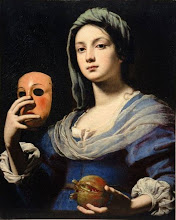
Song Ling, Innocence
Without innocence liberalism is permissiveness,
and conservatism is fascism.
Fascism destroys the innocent quickly;
Permissiveness destroys them more slowly.
That is the only difference.
Refuting the mystical, metaphysical concept of the existence of individual, discrete selves (while bearing in a non existent mind, that there is no universally accepted theory as to what the word "existence" means)





Consciousness is associated in particular with the Visshuddhi Chakra (subtle centre located on the throat but which is also the origin of the brain). It is believed that play evolved in order to develop consciousness in living creatures. Intelligent creatures, such as dolphins and apes, tend to be playful. There are many stories about the playfulness of Shri Krishna, the aspect of the Divine who rules over the Visshuddhi Chakra, and whose life exemplified social being, the interplay of collectivity.
."At one time it looked like all physical causation was push/pull Newtonianism", says Owen Flanagan, professor of philosophy and neurobiology at Duke University, North Carolina. "Now we have a new understanding of physics. What counts as material has changed. Some respectable philosophers think that we might have to posit sentience as a fundamental force of nature or use quantum gravity to understand consciousness. These stretch beyond the bounds of what we today call 'material', and we haven't discovered everything about nature yet. But what we do discover will be natural, not supernatural."New Scientist 25 October 2008


It's kind of fun to project human egoistic foibles onto animals, but the reality is that they do not have ego at all. They are, what is called in Hindu philosophy, pashu - completely bound to, and integrated with, the Self. However, this doesn't mean they don't have personalities. The difference between ego and personality is that the former is illusory while the latter is a real manifestation - a facet - of the singular but multifaceted Self. Ego is not a component of the true personality, it occludes the real personality.
."According to one influential school of thought, some of the ways we think about our minds have to go beyond our investigations of what is inside our heads to include the physical and social environment surrounding our heads. This idea is prompted by the thought that what we know when we understand a concept has to involve a connection between a brain event and something in the world. Here is an obvious example: to understand the concept of a flower, and to be able to distinguish between flowers and other things - trees and buildings say - the relevant physiological occurrences inside the head have to stand in a determinate relationship with flowers and non-flowers outside the head. This relationship, again obviously, is empirical: an actual perceptual encounter between the head's owner and flowers (or at least pictures of flowers) must have taken place at some point.But a less obvious aspect of having a concept of flowers is that whenever we think of flowers, the relationship between what is happening inside our heads and flowers outside our heads has to remain in some form, in order for our discourse to be about flowers rather than some other thing. Nothing mysterious or magical is implied by this; it just means that to explain the thought of a flower as distinct from a thought of anything else, reference to flowers out there in the world is unavoidable.The notion that thought is thus essentially connected to the outside world is intended to illustrate the more general idea that "mind" is not describable in terms of brain activity alone. Instead, it must be understood as a relationship between that activity and the external social and physical environment. Philosophers give the name "broad content" to thoughts that can only be properly described in terms of their thinkers' relationship to the environment. Some even argue that there can be no such thing as "narrow content" - that is, thoughts that are specifiable independently of their thinkers' environments and just in terms of what is going on inside the skull.If it is right that all content is broad content, then the implications are very great. It means that understanding minds involves much more than understanding brains alone. It involves understanding language, society and history too."- A.C. GraylingNew Scientist, 4 October 2008







That love is all there is
Is all we know of love
-Emily Dickinson
